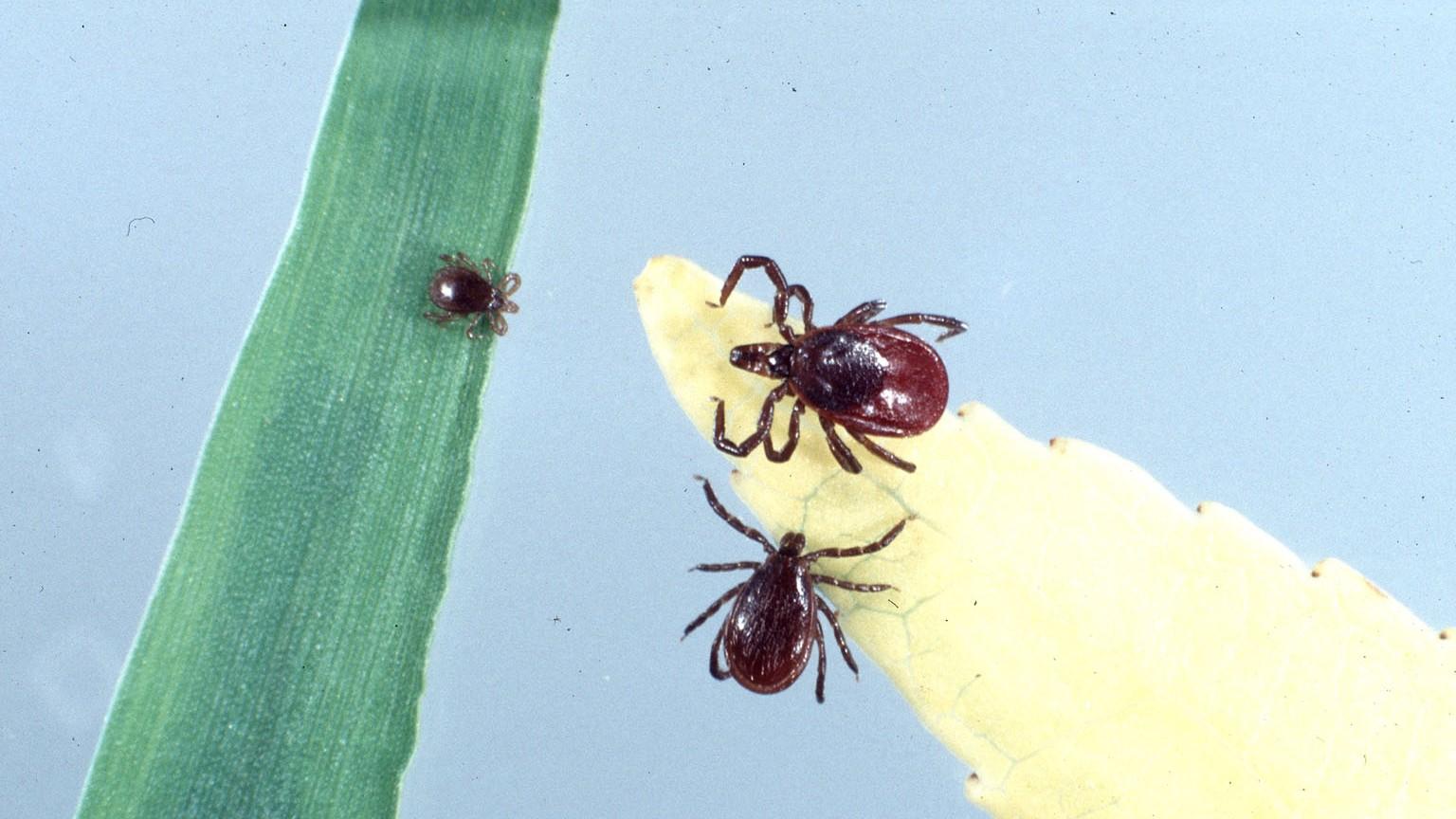Although ticks appear like small insects, they are actually arachnids (like spiders and mites). They have four life stages (egg, larva, nymph, adult) and they require three blood meals to complete their lifecycle. Ticks find their host by hanging on to leaves or grasses with their back legs and reaching out with their front legs. When a host comes by, they grab on and quickly crawl on to the host. Ticks do not fly, jump, or fall from trees. Ticks are not killed by freezing temperatures and are active on days when temperatures are above freezing.
Ticks can carry serious diseases that affect humans and pets. Most ticks are not born carrying disease-causing pathogens. They acquire pathogens by feeding on infected wildlife such deer and mice. If a disease-infected tick bites you, it takes 24-48 hours to transmit the pathogen (if the tick remains attached). Here are key things to know about ticks in Maryland and how to protect yourself from bites.
There are six species of ticks found in Maryland and the majority of them are capable of transmitting diseases. Ticks can be identified based on the shape, color, and pattern of the plate or scutum behind their head. (For photos, see Maryland Tick Identification Chart in Additional Resources below.)
American dog tick (wood tick)
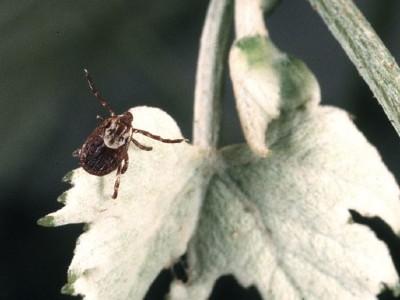
American dog tick (Dermacentor variabilis). Photo: Jim Occi, BugPics, Bugwood.org
This tick commonly feeds on dogs and humans. It transmits Rocky Mountain spotted fever, tularemia, and tick paralysis. Their scutum is oval in shape and has large whitish markings on it. They are found in areas with little or no tree cover.
-
When are they most active?
Adults: April-early August
Nymphs: May-July
Larvae: April-September
Blacklegged tick or deer tick
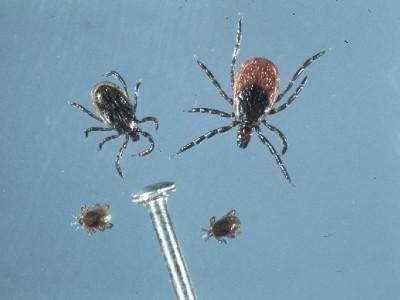
Blacklegged ticks (Ixodes scapularis). Photo: Jim Occi, BugPics, Bugwood.org
This tick is mostly found in deciduous forest and is the primary carrier of Lyme disease. Distribution relies greatly on that of its reproductive host, white-tailed deer. Adult ticks feed during the winter on white-tailed deer. The larval and nymphal ticks are found throughout the summer and feed on small mammals such as mice, chipmunks, and voles. The preferred host is the white-footed mouse. This tick can also spread anaplasmosis, babesiosis, and Powassan disease. They have a round dark brown/blackish scutum.
-
When are they most active?
Adults: all year
Nymphs: May-August
Larvae: July-September
Life cycle of blacklegged tick
Brown dog tick
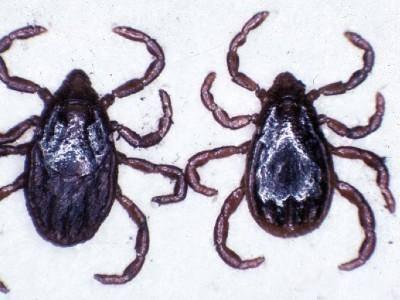
Brown dog tick (Rhipicephalus sanguineus). Photo: Mat Pound, USDA Agricultural Research Service, Bugwood.org
This tick prefers to feed on dogs, and it is sometimes found in homes. Brown dog ticks can spread Rocky Mountain spotted fever, canine ehrlichiosis and canine babesiosis. They have an oval fan brown scutum.
-
When are they most active?
Adults: all year
Nymphs: all year
Larvae: all year
Lone star tick
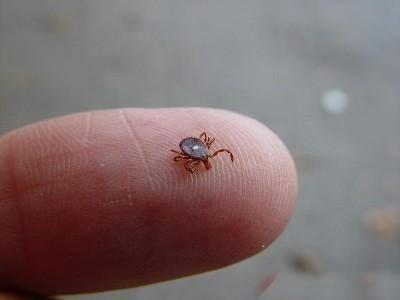
Lone star tick (Amblyomma americanum). Photo: Gerald Holmes, California Polytechnic State University at San Luis Obispo, Bugwood.org
This tick is found mostly in woodlands with dense undergrowth and around animal resting areas. It can transmit human ehrlichiosis, tularemia, Southern tick-associated rash illness, and meat allergy. It has a triangle shaped scutum with white to light yellow dot on the peak.
-
When are they most active?
Adults: April-late August
Nymphs: May-early August
Larvae: July-late September
Gulf coast tick
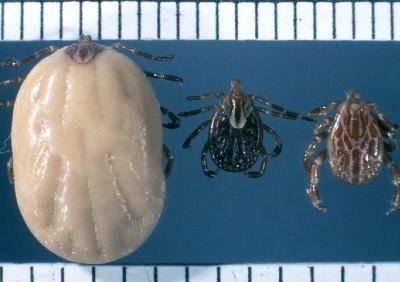
Gulf coast tick (Amblyomma maculatum). Photo: Jim Occi, BugPics, Bugwood.org
This tick is found in grass prairies and coastal uplands. It is not very common in Maryland. It can transmit Rickettsia parkeri spotted fever.
Asian longhorned tick

Asian longhorned tick (Haemaphysalis longicornis). Photo: Eric R. Day, Virginia Polytechnic Institute and State University, Bugwood.org
Asian longhorned tick (Haemaphysalis longicornis), also known as the longhorned tick, cattle tick, East Asian tick, and the bush tick, is native to East Asian and was discovered in Maryland in 2018. This tick prefers to feed on wildlife and livestock, but it feeds on pets and humans as well. Read more about Asian longhorned ticks.
How to protect yourself from ticks
-
Wear long pants, long sleeves, and close-toed shoes. Tuck pants into socks. Tuck shirts into pants.
-
Wear clothing/shoes treated with the tick repellent permethrin. It kills ticks on contact with the clothing.
-
Avoid sitting on logs, stumps, or the ground in brushy areas. Periodically inspect clothing and your body before ticks become attached. Use a lint roller brush to remove ticks from clothing.
-
Use insect repellents (such as DEET) according to label directions. Put sunscreen on first, then repellent. Never use DEET under clothing or on pets.
-
Shower when possible after being outdoors.
-
Throw clothes in a hot dryer for 10 minutes before washing, to kill any lingering ticks that may be attached to clothing.
Tick prevention around the home and yard
-
Focus on areas frequently used by people.
-
Trim back vegetation along paths, trails, and yard edges. Remove leaf litter around buildings and forest edges.
-
Keep bird feeders at the edge of the yard and clean up debris to discourage rodents.
-
Reduce rodent habitat which are a major tick carrier.
-
Keep weeds down.
-
Stack wood neatly in a dry area.
-
Clean up and seal stone walls.
-
Remove leaves around walls and woodpiles.
-
Control deer around your property. Use plants that are less desirable to deer. Apply deer repellents and/or deer fence.
-
How to remove a tick
If a tick is found attached, remove it as soon as possible with a slow, steady pull. It is best to use forceps with the tips placed on or just behind the mouthparts. Pull the tick’s body away from your skin. DO NOT USE Vaseline, liquid soap, a cotton ball, or touch it with a match. It is okay if the tick’s head or mouthparts remain in the skin. Disinfect the attachment area. Save the tick on a piece of clear tape and place it in the freezer, noting the date it was removed. You can send the tick to a lab to be identified.
Where to get a tick identified and tested
-
Use the Tick Identification service at the University of Maryland.
-
The diagnostic lab at UMASS Amherst identifies ticks and tests for the most common pathogens based on tick species. Write down the date of the tick bite and/or removal date for reference. Make sure the zipper-lock bag with your sample is tightly sealed so the tick cannot escape.
Additional resources
TickEncounter Resource Center from the University of Rhode Island is the best one-stop shop for resources on ticks. Excellent photos, best practices, and tips.
Tick Removal Information from the Centers for Disease Control
Lyme Disease Information and Lyme Disease Fact Sheet from the Maryland Department of of Health and Mental Hygiene
Edited by Christa Carignan, Coordinator, Home & Garden Information Center; Reviewed by Emily Zobel, University of Maryland Extension, 1/2018, revised 2/2021.
